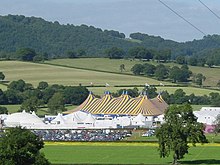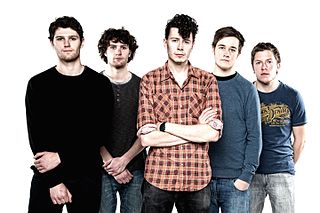
Maes (Welsh for Field) is the name commonly given to the site of a Welsh eisteddfod, such as the National Eisteddfod or the Urdd Eisteddfod. All the main events and event venues are located on the Maes. [1]

Maes (Welsh for Field) is the name commonly given to the site of a Welsh eisteddfod, such as the National Eisteddfod or the Urdd Eisteddfod. All the main events and event venues are located on the Maes. [1]
Central to the Maes is the competition venue, often a large temporary pavilion. From 2006 until 2014, the National Eisteddfod of Wales used a large pink pavilion, which arrived in four articulated lorries and took four days to erect. Prior to that, the pavilion had been a stripy green and yellow tent. [2]
The Maes is usually located in a field or on open farmland. In 2017 the National Eisteddfod of Wales was almost cancelled when, on the initial weekend of the event, the Maes was turned into a sea of mud by stormy weather. The carparks on nearby farmland became unusable. A later report also concluded the accessibility for disabled visitors to the Maes was inadequate. [3]
Normally the Maes is enclosed by a fence and an entrance fee is charged. However, in 2018 the National Eisteddfod was held in Cardiff Bay with an open, fence-free Maes. Existing, permanent buildings were used in the immediate area for the competitions and events, with an admission fee charged for these. Because of the additional security costs the event lost £290,000, but attracted an estimated 500,000 visitors, as opposed to the usual 150,000. [4]
Maes of the National Eisteddfod from early years divided into different fields and Maes B began as the alternative field purely for young people.
Since 1997 Maes B is a regular music event (and venue) at the National Eisteddfod of Wales, featuring a line-up of contemporary Welsh language rock and pop musicians. [5]
Nansi Richards Jones was a Welsh harpist, sometimes known as the "Queen of the Harp" or by her bardic name "Telynores Maldwyn".
This article is about the particular significance of the year 2004 to Wales and its people.

The National Eisteddfod of Wales is the most important of several eisteddfodau that are held annually, mostly in Wales. Its eight days of competitions and performances are considered the largest music and poetry festival in Europe. Competitors typically number 6,000 or more, and overall attendance generally exceeds 150,000 visitors. The 2018 Eisteddfod was held in Cardiff Bay with a fence-free 'Maes'. In 2020, the event was held virtually under the name AmGen; events were held over a one-week period.

The Chairing of the Bard is one of the most important events in the Welsh eisteddfod tradition. The most famous chairing ceremony takes place at the National Eisteddfod of Wales, and is always on the Friday afternoon of Eisteddfod week. Winners are referred to as Y Prifardd. The custom of chairing the bard is, however, much older than the modern eisteddfod ceremony, and is known to have taken place as early as 1176.

Elin Fflur Llewelyn Harvey, known professionally as Elin Fflur, is a Welsh singer-songwriter, television and radio presenter.

Anglesey Airport is an airport owned by the Isle of Anglesey County Council on land leased from the Defence Infrastructure Organisation. The airport is situated at Llanfair-yn-Neubwll in Anglesey, Wales. The leased site is part of RAF Valley.

The Urdd National Eisteddfod is an annual Welsh-language youth festival of literature, music and performing arts organised by Urdd Gobaith Cymru. Arguably Europe's largest youth festival, it is usually held during the last week of May, coinciding with schools' half term holiday. Locations alternate between north and south Wales. The Eisteddfod consists of competitive singing, recitation, art, composition, dance and instrumental events for contestants aged between 7 and 24 years. Regional qualifying heats are held in advance around Wales.

T. James Jones is a Welsh poet and dramatist, and former Archdruid of the National Eisteddfod of Wales. He is also known by the bardic name Jim Parc Nest.
Geraint Lloyd Owen is a Welsh-language poet, also known by his bardic name Geraint Llifon. He is a retired head teacher and was the Archdruid of the Gorsedd between 2016 and 2019.

The Gold Medal of the National Eisteddfod of Wales is awarded annually in three categories for excellence in Fine Art, Architecture, or Craft and Design.
Gareth Finlay Williams was a Welsh language author who wrote novels for children and adults, as well as creating many television drama series.
This article is about the particular significance of the year 2017 to Wales and its people.

Candelas are a Welsh rock band from Llanuwchllyn, North Wales.
Arfon Haines Davies is a Welsh television presenter who began his career as a continuity announcer for HTV Wales during the 1970s and 1980s.

Y Lle Celf is an annual art, craft and architecture exhibition held during the National Eisteddfod of Wales, claimed to be the biggest temporary art exhibition in Europe.

Catrin Dafydd is a Welsh author, scriptwriter and poet, who was awarded the Crown at the 2018 National Eisteddfod of Wales.
Events from the year 2019 in Wales.
Guto Dafydd is a Welsh poet and novelist, who writes in the Welsh language. He has twice won the Crown at the National Eisteddfod of Wales and is twice winner of the Daniel Owen Prize for a novel.

The 2018 Cardiff National Eisteddfod was held in Cardiff Bay, Wales, from 3 to 11 August 2018. It was the seventh time the National Eisteddfod of Wales had been held in Cardiff. The 2018 event was billed as the Eisteddfod with "No fences" because it dispensed with the traditional enclosed 'Maes', or entrance fees to the event location. It made a £290,000 loss, but its popularity led to the suggestion of future Eisteddfods without fences.
Lleucu Roberts is a Welsh author.